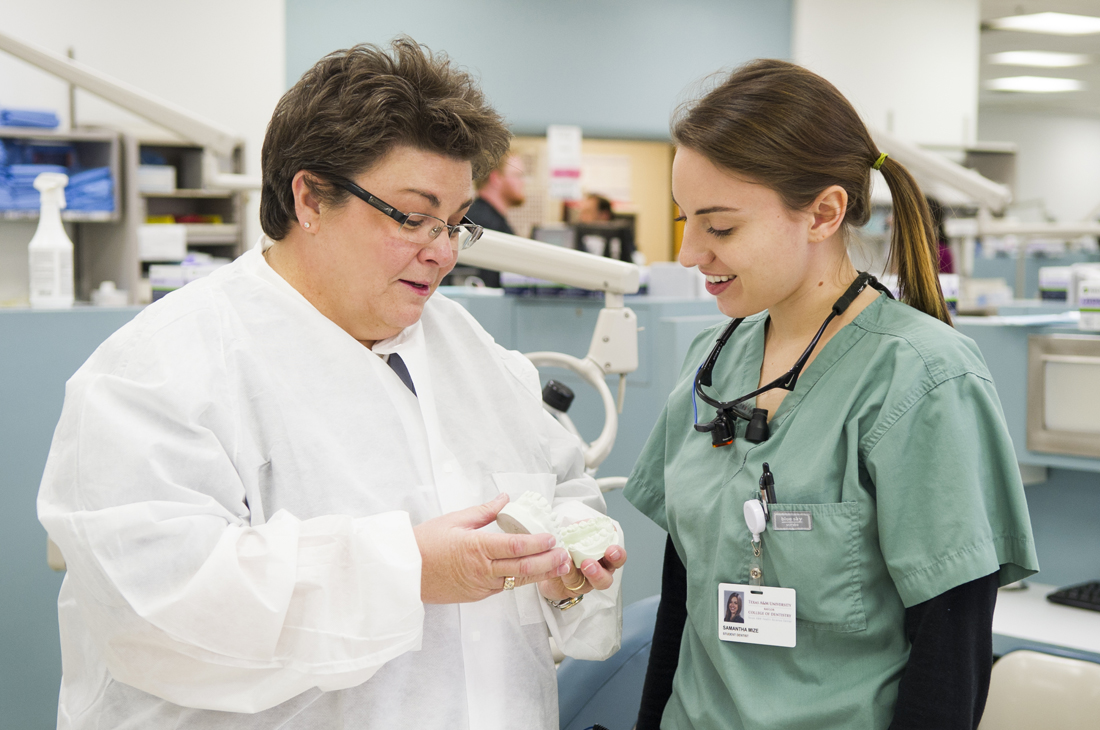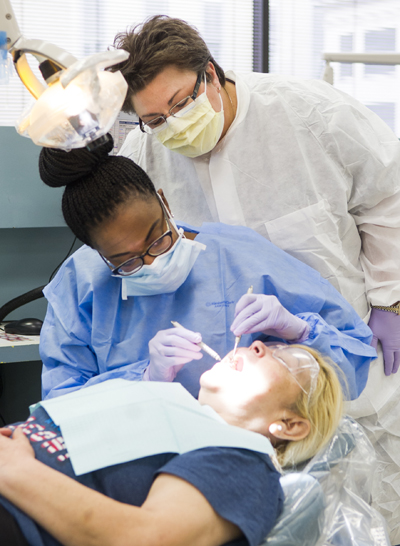Progress notes

Periodontics professor Jacqueline “Jacque” Plemons ’86 ’88 was recently named director of stomatology in the Clinical Center for Stomatology, Department of Periodontics at Texas A&M College of Dentistry.
“Besides all of her many accolades, her main character attribute that immediately qualifies her for a leadership position is that she deeply cares—about her patients, about her colleagues, and about the department,” says Dr. Thomas Diekwisch, periodontics department head.

Dr. Plemons says she was first drawn to oral medicine while working with a group of oral cancer survivors when she was a resident here in the late ’80s. Because those patients’ conditions fell somewhere between oral and medical health, they often struggled to find the specialized care they needed. Their plight became Plemons’ passion as she helped move the dental school’s efforts forward in managing this group’s much-needed care.
“Being able to provide care that addresses both aspects of patients’ needs made our clinic unique and our efforts very gratifying,” says Plemons, who is also president of the Texas Dental Association.
While she works closely with Dr. Celeste Abraham, clinical associate professor in periodontics, the oral and maxillofacial pathology faculty are quick to lend a hand when needed.
“Plemons has improved clinic productivity, patient care, and continuously updated the Stomatology curriculum to meet our residents’ needs and to continue our instructional portfolio during the COVID-19 pandemic,” Diekwisch says.
She earned her master’s in oral biology and a periodontics certificate in 1988 from Baylor College of Dentistry (now Texas A&M College of Dentistry), where she completed her dental degree in 1986. Plemons also completed a Fellowship in Oral Medicine and has advanced training in dental implants and dental anesthesiology. She attended Texas A&M University for her undergraduate studies. In 2014, she was named Dentist of the Year by the Dallas County Dental Society.
The Stomatology Clinic can be found in the Graduate Periodontics Clinic on the sixth floor in the new clinical building. Graduate students see patients from 10 a.m. to noon on Tuesdays and Thursdays. Faculty see patients throughout the year, although clinical care and hours have been impacted by the COVID-19 pandemic. Plemons spends Tuesday/Thursday afternoons in the Predoctoral Periodontics Clinic. She will still work in her private practice on Monday mornings, Wednesdays and Fridays.
What personal experiences inspired your interest in stomatology and your commitment to patients who suffer from these rare and often debilitating conditions?
I think we all want to feel that we make a difference in our efforts regarding our professional careers, and probably in life in general. In stomatology, I routinely saw patients in my residency who were suffering and felt they had nowhere to turn to get the help they desperately needed. Many of the conditions we saw in these patients were medical conditions that manifested in the oral cavity. As a result, patients and the care they needed fell in a gap between medicine and dentistry.
More specifically, I was drawn to oral medicine when I had the opportunity to participate in the care of a group of oral cancer survivors. One patient had surgery that included the removal of most of her tongue. She struggled to speak and I struggled to understand her. She could no longer take food by mouth and she suffered from severe xerostomia. As we both worked hard to improve her quality of life, she showed me the strength of the human spirit. She has been gone a long time now, but I still remember our visits as some of the most moving experiences in my life. To know that I helped her even a little is a privilege that I hold close to my heart.
From your vantage point, what new diagnostics or clinical modalities do you see on the horizon that offer the potential to enhance quality of life for stomatology patients?
Research in oral medicine currently centers on clinical, translational bench-top and bioinformatics projects exploring both the impact of systemic disease on the oral cavity and systemic implications for oral disease. As far as diagnostics go, much attention is being given to the potential diagnosis of systemic and oral diseases/conditions such as Sjogren’s syndrome, viral infections and oral cancer based on salivary biomarkers. Clinical research on new treatment modalities will continue to include product testing and interventional studies involving new medications, such as biologics and other systemic medications, and new methods of drug application, such as topical sustained-released products and laser therapy.
What have your patients taught you?
Over the years, caring for oral medicine patients has reinforced my commitment to lifelong learning. Patients have shown me the power of the human spirit in facing the diagnosis and treatment of life-threatening and certainly life-altering diseases or conditions. They have also reminded me of the importance of listening and the incredible value of patience. It’s through the care of these patients that I feel I’ve done the most “good” in my life.